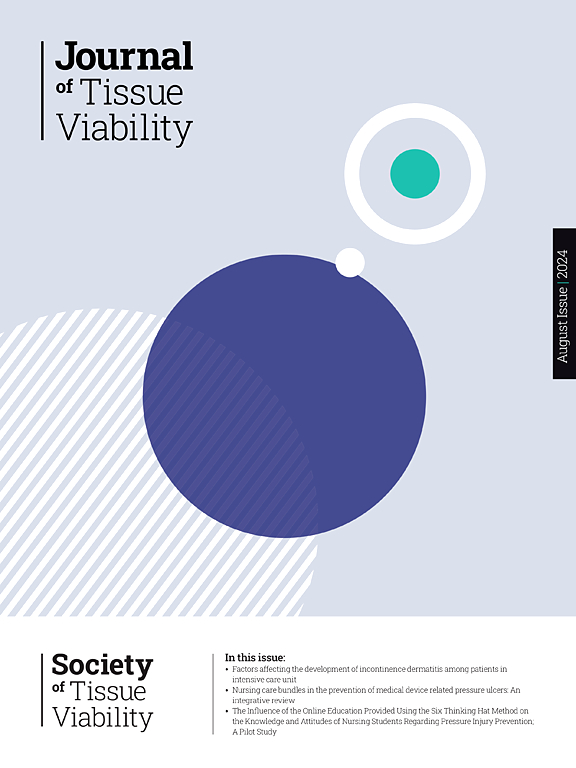医护人员在评估术后伤口照片是否存在手术伤口开裂时的评分者间可靠性:前测-后测研究。
IF 2.4
3区 医学
Q2 DERMATOLOGY
引用次数: 0
摘要
背景:手术伤口开裂(SWD)有多种定义,这使得准确统一的诊断变得复杂。为了解决这一问题,世界伤口愈合学会联盟(WUWHS)提出了基于共识的 SWD 定义和分类(2018 年)。目的:本准实验性研究探讨了医护人员(HCP)和伤口护理专业人员(WCP)在接受 WUWHS 定义培训前后评估伤口照片是否存在 SWD 时的相互评分可靠性:方法:伤口专家小组制作了一组 20 张照片(SWD+:19 张,SWD-:1 张)和一个培训视频。随后,262 名医护人员收到了评估伤口照片的前测链接。完成后,参与者会收到后测链接,其中包括关于 WUWHS 定义的(视频)培训,以及对 14 张照片(SWD+:13 张,SWD-:1 张)的重新评估:次要结果:对 WUWHS 定义的熟悉程度:131 名参与者(65 名 HCP,66 名 WCP)完成了这两项测试。参与者在测试后正确识别社署的评分者间可靠性从 67.6% 提高到 76.2%,达到统计学意义(p 值:0.001;95% 置信区间 [1.8-2.2])。对每张照片进行的子分析表明,有 13 张照片的后测得分有所提高,有 7 张照片的后测得分达到了统计学意义。有 33% 的参与者知道 WUWHS 的定义:结论:在接受了关于 WUWHS 定义的培训后,参与者之间的互评可靠性有所提高。该定义为准确诊断 SWD 提供了诊断标准。广泛使用该定义可提高对 SWD 患者护理的一致性。本文章由计算机程序翻译,如有差异,请以英文原文为准。
Inter-rater reliability among healthcare professionals in assessing postoperative wound photos for the presence or absence of surgical wound dehiscence: A Pretest - Posttest study
Background
Surgical wound dehiscence (SWD) has various definitions, which complicates accurate and uniform diagnosis. To address this, the World Union Wound Healing Societies (WUWHS) presented a consensus based definition and classification for SWD (2018).
Aim
This quasi-experimental pretest-posttest study investigates the inter-rater reliability among healthcare professionals (HCP) and wound care professionals (WCP) when assessing wound photos on the presence or absence of SWD before and after training on the WUWHS-definition.
Methods
Wound expert teams compiled a set of twenty photos (SWD+: nineteen, SWD−: one), and a video training. Subsequently, 262 healthcare professionals received the pretest link to assess wound photos. After completion, participants received the posttest link, including a (video) training on the WUWHS-definition, and reassessment of fourteen photos (SWD+: thirteen, SWD−: one).
Primary outcomes
1) pretest-posttest inter-rater-reliability among participants in assessing photos in congruence with the WUWHS-definition 2) the impact of training on assessment scores. Secondary outcome: familiarity with the WUWHS-definition.
Results
One hundred thirty-one participants (65 HCPs, 66 WCPs) completed both tests. The posttest inter-rater reliability among participants for correctly identifying SWD was increased from 67.6 % to 76.2 %, reaching statistical significance (p-value: 0.001; 95 % Confidence Interval [1.8–2.2]).
Sub-analyses per photo showed improved SWD posttest scores in thirteen photos, while statistical significance was reached in seven photos.
Thirty-three percent of participants knew the WUWHS-definition.
Conclusion
The inter-rater reliability among participants increases after training on the WUWHS-definition. The definition provides diagnostic criteria for accurate SWD diagnosis. Widespread use of the definition may improve uniformity in care for patients with SWD.
求助全文
通过发布文献求助,成功后即可免费获取论文全文。
去求助
来源期刊

Journal of tissue viability
DERMATOLOGY-NURSING
CiteScore
3.80
自引率
16.00%
发文量
110
审稿时长
>12 weeks
期刊介绍:
The Journal of Tissue Viability is the official publication of the Tissue Viability Society and is a quarterly journal concerned with all aspects of the occurrence and treatment of wounds, ulcers and pressure sores including patient care, pain, nutrition, wound healing, research, prevention, mobility, social problems and management.
The Journal particularly encourages papers covering skin and skin wounds but will consider articles that discuss injury in any tissue. Articles that stress the multi-professional nature of tissue viability are especially welcome. We seek to encourage new authors as well as well-established contributors to the field - one aim of the journal is to enable all participants in tissue viability to share information with colleagues.
 求助内容:
求助内容: 应助结果提醒方式:
应助结果提醒方式:


